
3C-P (α-Methyl-4-propoxy-3,5-dimethoxyphenethylamine) is a psychedelic phenethylamine. It has structural and pharmacodynamic properties similar to the drugs mescaline, proscaline, and amphetamine. Little information exists on the human pharmacology of 3C-P, but a psychedelic dosage appears to be 20–40 mg, and is accompanied by stimulant and psychedelic effects such as visual enhancement and distortion. It can be synthesized from syringaldehyde by reaction with n-propyl iodide followed by condensation with nitroethane and reduction.

2C-TFM is a psychedelic phenethylamine of the 2C family. It was first synthesized in the laboratory of David E. Nichols. It has also been called 2C-CF3, a name derived from the Para-trifluoromethyl group it contains.
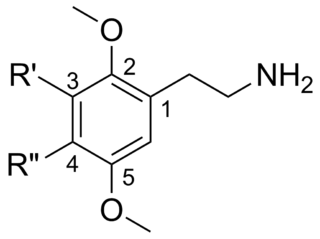
2C (2C-x) is a general name for the family of psychedelic phenethylamines containing methoxy groups on the 2 and 5 positions of a benzene ring. Most of these compounds also carry lipophilic substituents at the 4 position, usually resulting in more potent and more metabolically stable and longer acting compounds. Most of the currently known 2C compounds were first synthesized by Alexander Shulgin in the 1970s and 1980s and published in his book PiHKAL. Shulgin also coined the term 2C, being an acronym for the 2 carbon atoms between the benzene ring and the amino group.
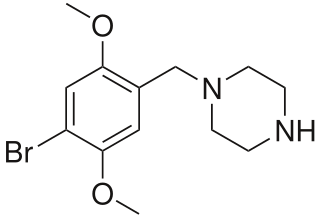
4-Bromo-2,5-dimethoxy-1-benzylpiperazine (2C-B-BZP) is a psychoactive drug and research chemical of the piperazine chemical class which has been sold as a "designer drug". It produces stimulant effects similar to those of benzylpiperazine (BZP).

2C-YN is an analog of phenethylamine that can be synthesized from 2C-I. Very little data exists about the pharmacological properties, metabolism, and toxicity of 2C-YN, although Daniel Trachsel lists it as having a dosage of around 50mg and a duration of around 2 hours, with relatively mild psychedelic effects.

4-Substituted-2,5-dimethoxyamphetamines (DOx) is a chemical class of substituted amphetamine derivatives featuring methoxy groups at the 2- and 5- positions of the phenyl ring, and a substituent such as alkyl or halogen at the 4- position of the phenyl ring. Most compounds of this class are potent and long-lasting psychedelic drugs, and act as highly selective 5-HT2A, 5-HT2B, and 5-HT2C receptor partial agonists. A few bulkier derivatives such as DOAM have similarly high binding affinity for 5-HT2 receptors but instead act as antagonists, and so do not produce psychedelic effects though they retain amphetamine-like stimulant effects.
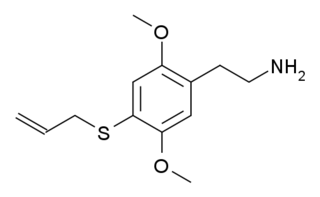
2C-T-16 is a lesser-known psychedelic drug. It was originally named by Alexander Shulgin as described in his book PiHKAL, however while Shulgin began synthesis of this compound he only got as far as the nitrostyrene intermediate, and did not complete the final synthetic step. Synthesis of 2C-T-16 was finally achieved by Daniel Trachsel some years later, and it was subsequently reported as showing similar psychedelic activity to related compounds, with a dose range of 10–25 mg and a duration of 4–6 hours, making it around the same potency as the better-known saturated analogue 2C-T-7, but with a significantly shorter duration of action. Binding studies in vitro showed 2C-T-16 to have a binding affinity of 44 nM at 5-HT2A and 15 nM at 5-HT2C. 2C-T-16 and related derivatives are potent partial agonists of the 5-HT1A, 5-HT2A, 5-HT2B and 5-HT2C receptors and induce a head-twitch response in mice.
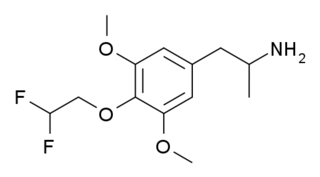
3C-DFE is a lesser-known psychedelic drug, which is a fluorinated derivative of 3C-E. It was first synthesised by Daniel Trachsel in 2002, and has been reported as showing similar psychedelic activity to related compounds, with a dose range of around 20–40 mg and a duration of approximately 10 hours. Despite its reported psychedelic activity, binding studies in vitro showed 3C-DFE to have a surprisingly weak binding affinity of 2695 nM at 5-HT2A with negligible affinity at 5-HT2C, making it only slightly higher affinity than mescaline, despite its higher potency in vivo.
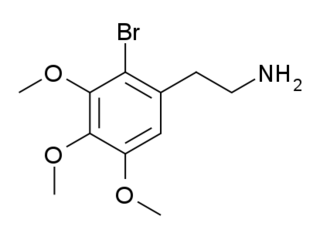
2-Bromomescaline (2-Br-M) is a derivative of the phenethylamine hallucinogen mescaline which has an unusual 2-bromo substitution. It is an agonist for serotonin receptors, with a binding affinity of 215 nM at 5-HT1A, 513 nM at 5-HT2A and 379 nM at 5-HT2C, so while it is around ten times more tightly binding than mescaline at 5-HT1A and 5-HT2A receptors, it is over twenty times more potent at 5-HT2C.

2C-Se is a lesser-known psychedelic drug. It was originally named by Alexander Shulgin as described in his book PiHKAL. Shulgin considered 2C-Se to be around three times the potency of mescaline, but was too concerned about toxicity to test it extensively, though he considered it noteworthy as the only psychedelic drug to contain a selenium atom.

2C-EF is a lesser-known psychedelic drug. It was originally named by Alexander Shulgin as described in his book PiHKAL, but he never synthesised it himself, though it has been synthesised and its activity tested in subsequent years.

2C-TFE is a lesser-known psychedelic drug related to compounds such as 2C-E and 2C-TFM. It was first synthesised by Daniel Trachsel, and is reportedly a potent psychedelic with an active dose in the 5–15 mg range, and a long duration of action of 12–24 hours.

2C-T-3 is a lesser-known psychedelic drug related to compounds such as 2C-T-7 and 2C-T-16. It was named by Alexander Shulgin but was never made or tested by him, and was instead first synthesised by Daniel Trachsel some years later. It has a binding affinity of 11nM at 5-HT2A and 40nM at 5-HT2C. It is reportedly a potent psychedelic drug with an active dose in the 15–40 mg range, and a duration of action of 8–14 hours, with visual effects comparable to related drugs such as methallylescaline.

3C-AL (4-Allyloxy-3,5-dimethoxyamphetamine) is a psychedelic phenethylamine with structural similarities to allylescaline. Little information exists on the human pharmacology of 3C-AL and it has little-to-no history of human use. It can be synthesized from syringaldehyde by reaction with allyl iodide followed by condensation with nitroethane and reduction. The hydrochloride salt is a white crystal with a melting point of 180–181°C.

3C-MAL (4-Methylallyloxy-3,5-dimethoxyamphetamine) is a psychedelic phenethylamine with structural similarities to methallylescaline. Little information exists on the human pharmacology of 3C-MAL and it has little-to-no history of human use. The hydrochloride salt is a white crystal with a melting point of 159–160 °C (318–320 °F).

2C-T-28 is a lesser-known psychedelic drug related to compounds such as 2C-T-7 and 2C-T-21. It was named by Alexander Shulgin but was never made or tested by him, and was instead first synthesised by Daniel Trachsel some years later. It has a binding affinity of 75 nM at 5-HT2A and 28 nM at 5-HT2C. It is reportedly a potent psychedelic drug with an active dose in the 8–20 mg range, and a duration of action of 8–10 hours, with prominent visual effects. 2C-T-28 is the 3-fluoropropyl instead of 2-fluoroethyl chain-lengthened homologue of 2C-T-21 and has very similar properties, although unlike 2C-T-21 it will not form toxic fluoroacetate as a metabolite.

2C-CP (2C-cP) is a recreational designer drug from the substituted phenethylamine family, with psychedelic effects. It was first synthesised by Daniel Trachsel and colleagues in 2006. It has a binding affinity (Ki) of 95 nM at the serotonin receptor 5-HT2A and 41 nM at 5-HT2C and is active at a dosage of between 15 and 35 mg with a duration of 3 to 6 hours.

2C-V is a recreational designer drug from the substituted phenethylamine family, with psychedelic effects. It was first synthesised by Daniel Trachsel and colleagues in 2006. It is active at a dosage of 25 mg with a duration of around 5 hours.

β-Methyl-2C-B (BMB) is a recreational designer drug with psychedelic effects. It is a structural isomer of DOB but is considerably less potent, having around half the potency of 2C-B itself with activity starting at a dosage of around 20 mg. It has two possible enantiomers but their activity has not been tested separately.
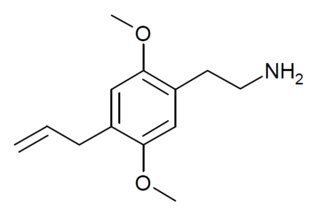
2C-AL is a drug from the substituted phenethylamine family which acts as an agonist of the 5-HT2A receptor, with an EC50 of 2.15nM at 5-HT2A vs 77.71nM at 5-HT2B, and produces a head-twitch response in animal studies. It was first discussed as a hypothetical compound in Daniel Trachsel's 2013 review of the field after his successful synthesis of the related compounds 2C-V and 2C-YN, and finally synthesised by a team at Gilgamesh Pharmaceuticals in 2020 using a different synthetic route from that employed by Trachsel.




















